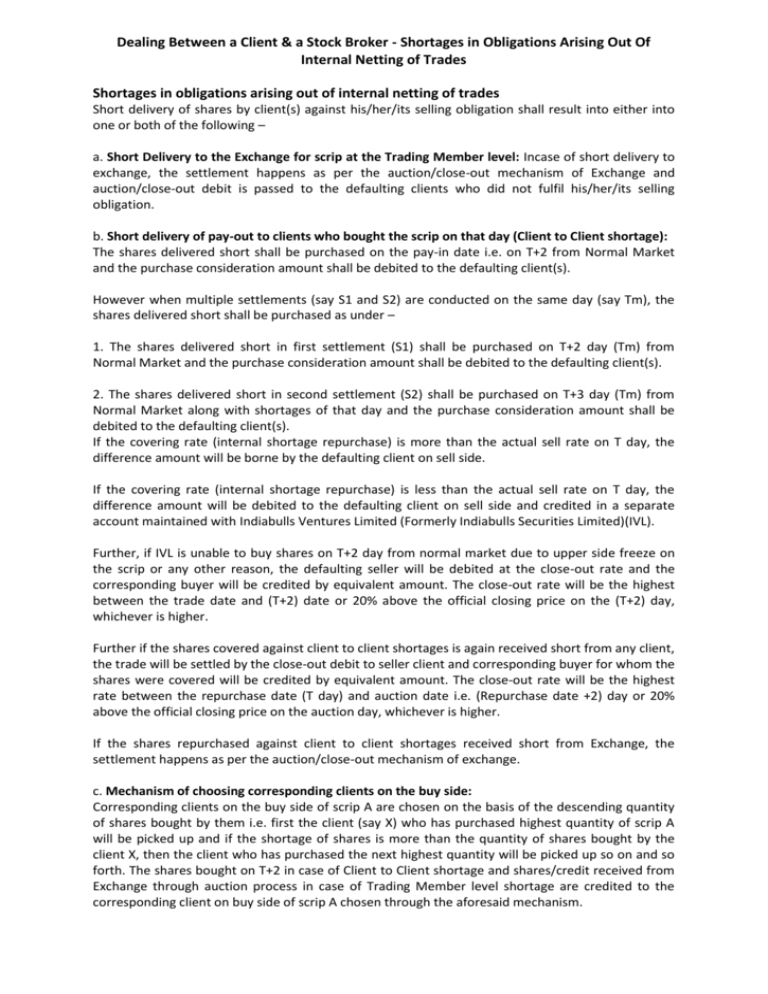Dealing Between a Client & a Stock Broker
advertisement

Dealing Between a Client & a Stock Broker - Shortages in Obligations Arising Out Of Internal Netting of Trades Shortages in obligations arising out of internal netting of trades Short delivery of shares by client(s) against his/her/its selling obligation shall result into either into one or both of the following – a. Short Delivery to the Exchange for scrip at the Trading Member level: Incase of short delivery to exchange, the settlement happens as per the auction/close-out mechanism of Exchange and auction/close-out debit is passed to the defaulting clients who did not fulfil his/her/its selling obligation. b. Short delivery of pay-out to clients who bought the scrip on that day (Client to Client shortage): The shares delivered short shall be purchased on the pay-in date i.e. on T+2 from Normal Market and the purchase consideration amount shall be debited to the defaulting client(s). However when multiple settlements (say S1 and S2) are conducted on the same day (say Tm), the shares delivered short shall be purchased as under – 1. The shares delivered short in first settlement (S1) shall be purchased on T+2 day (Tm) from Normal Market and the purchase consideration amount shall be debited to the defaulting client(s). 2. The shares delivered short in second settlement (S2) shall be purchased on T+3 day (Tm) from Normal Market along with shortages of that day and the purchase consideration amount shall be debited to the defaulting client(s). If the covering rate (internal shortage repurchase) is more than the actual sell rate on T day, the difference amount will be borne by the defaulting client on sell side. If the covering rate (internal shortage repurchase) is less than the actual sell rate on T day, the difference amount will be debited to the defaulting client on sell side and credited in a separate account maintained with Indiabulls Ventures Limited (Formerly Indiabulls Securities Limited)(IVL). Further, if IVL is unable to buy shares on T+2 day from normal market due to upper side freeze on the scrip or any other reason, the defaulting seller will be debited at the close-out rate and the corresponding buyer will be credited by equivalent amount. The close-out rate will be the highest between the trade date and (T+2) date or 20% above the official closing price on the (T+2) day, whichever is higher. Further if the shares covered against client to client shortages is again received short from any client, the trade will be settled by the close-out debit to seller client and corresponding buyer for whom the shares were covered will be credited by equivalent amount. The close-out rate will be the highest rate between the repurchase date (T day) and auction date i.e. (Repurchase date +2) day or 20% above the official closing price on the auction day, whichever is higher. If the shares repurchased against client to client shortages received short from Exchange, the settlement happens as per the auction/close-out mechanism of exchange. c. Mechanism of choosing corresponding clients on the buy side: Corresponding clients on the buy side of scrip A are chosen on the basis of the descending quantity of shares bought by them i.e. first the client (say X) who has purchased highest quantity of scrip A will be picked up and if the shortage of shares is more than the quantity of shares bought by the client X, then the client who has purchased the next highest quantity will be picked up so on and so forth. The shares bought on T+2 in case of Client to Client shortage and shares/credit received from Exchange through auction process in case of Trading Member level shortage are credited to the corresponding client on buy side of scrip A chosen through the aforesaid mechanism.






